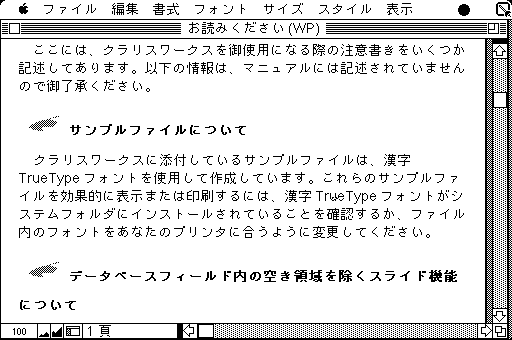This article is more than 1 year old
Selling Apples to Japan: Complicated as a Nipponese typewriter
One day, a surprising market walked in the door
So I asked Apple if we could get these products. The answer was a blunt no. They said that these were complex products that we could not support.
I protested that I was already supporting them. I sat down with the incomprehensible manuals, and just from the screenshots I learned how to demo KanjiTalk. I could input and display a few Japanese characters. I was already so familiar with the Mac menus, I knew where "Print" and "Save" were, even if I couldn't read the characters. All the shortcuts like Command-P and Command-S were the same in both languages.
Anything beyond that, my clients were already supporting themselves. My customers even gave me a bootleg copy of KanjiTalk, and I was successfully able to demonstrate its features to clients (who also begged me to sell it to them).

KanjiTalk
Japan was currently Apple's #2 market, but it was very costly to operate there, with too many middlemen. I proposed to cut out all the middlemen and sell directly to Japanese corporations in Los Angeles. My Apple regional rep reluctantly agreed that if I could produce a two-year business plan, they would consider it.
I went to my customers, who all committed to specific quantities of Macs and Laserwriter-J systems over two years. I estimated our store could sell $500,000 within two years, and we could afford a full-time Japanese-speaking technician after about six months.
I delivered a beautiful business plan. Of course we used our own best Mac DTP technologies to make our own documents look impressive. And then I heard nothing.
After two months, I thought I ought to take the initiative and see how my proposal was doing. I called and called, but nobody at Apple would get back to me. It was obvious they were avoiding me - I couldn't even get an appointment.
I finally decided to go to the regional office in person, without an appointment. I sat in the reception area for over an hour before they realized I wasn't going to leave. Finally, my Apple rep came out to speak to me briefly - ironically, she was a Japanese-American - and she said my proposal was declined. I asked why.
"Well, you don't speak Japanese!"
"Well, neither do you!" I said. "I sell spreadsheets, but I'm not a mathematician. I sell accounting software but I'm not a CPA. I already have orders for these products - all you have to do is ship some to me instead of Japan. They are the same Laserwriters we already sell and service, you just put different ROM chips in them."
But Apple would not budge. Well, not for me at least. Two months later, Apple announced its first Laserwriter-J/Kanjitalk dealership, a small computer store in Hawaii with total sales under $250k per year. And I was trying to sell $250k per year of these Japanese products as a sideline, probably about five per cent of my annual sales. I was infuriated.
Large corporations often don't realise the opportunities that are in front of them. Apple developed a breakthrough technology, but didn't know how to market it or maximize profits. They relied on their unique technology advantages, and let the market take care of itself.
Microsoft didn't support Japanese at all until 1993, when Windows 3.1J was released. Apple squandered its seven-year leadership, and Windows became the standard in Japan, just as it had worldwide. ®
Charles Eicher is an artist and multimedia producer in the American Midwest. He has a special interest in intellectual property rights in the Arts and Humanities. He writes at the Disinfotainment weblog.
